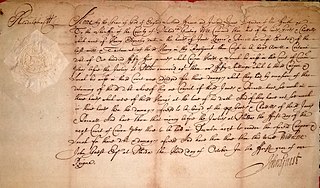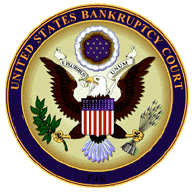
United States appellate procedure involves the rules and regulations for filing appeals in state courts and federal courts. The nature of an appeal can vary greatly depending on the type of case and the rules of the court in the jurisdiction where the case was prosecuted. There are many types of standard of review for appeals, such as de novo and abuse of discretion. However, most appeals begin when a party files a petition for review to a higher court for the purpose of overturning the lower court's decision.
In legal terminology, a complaint is any formal legal document that sets out the facts and legal reasons that the filing party or parties believes are sufficient to support a claim against the party or parties against whom the claim is brought that entitles the plaintiff(s) to a remedy. For example, the Federal Rules of Civil Procedure (FRCP) that govern civil litigation in United States courts provide that a civil action is commenced with the filing or service of a pleading called a complaint. Civil court rules in states that have incorporated the Federal Rules of Civil Procedure use the same term for the same pleading.
A tort is a civil wrong that causes a claimant to suffer loss or harm, resulting in legal liability for the person who commits the tortious act. In some, but not all, civil and mixed law jurisdictions, the term delict is used to refer to this category of civil wrong, though it can also refer to criminal offences in some jurisdictions and tort is the general term used in comparative law. The word tort stems from Old French via the Norman Conquest and Latin via the Roman Empire. The word 'tort' was first used in a legal context in the 1580s, although different words were used for similar concepts prior to this time.
Criminal procedure is the adjudication process of the criminal law. While criminal procedure differs dramatically by jurisdiction, the process generally begins with a formal criminal charge with the person on trial either being free on bail or incarcerated, and results in the conviction or acquittal of the defendant. Criminal procedure can be either in form of inquisitorial or adversarial criminal procedure.
In the United States, a state court has jurisdiction over disputes with some connection to a U.S. state. State courts handle the vast majority of civil and criminal cases in the United States; the United States federal courts are far smaller in terms of both personnel and caseload, and handle different types of cases.
A lawsuit is a proceeding by a party or parties against another in the civil court of law. The archaic term "suit in law" is found in only a small number of laws still in effect today. The term "lawsuit" is used in reference to a civil action brought by a plaintiff demands a legal or equitable remedy from a court. The defendant is required to respond to the plaintiff's complaint. If the plaintiff is successful, judgment is in the plaintiff's favor, and a variety of court orders may be issued to enforce a right, award damages, or impose a temporary or permanent injunction to prevent an act or compel an act. A declaratory judgment may be issued to prevent future legal disputes.

In common law, a writ is a formal written order issued by a body with administrative or judicial jurisdiction; in modern usage, this body is generally a court. Warrants, prerogative writs, subpoenas, and Certiorari are common types of writ, but many forms exist and have existed.
In law, a judgment, also spelled judgement, is a decision of a court regarding the rights and liabilities of parties in a legal action or proceeding. Judgments also generally provide the court's explanation of why it has chosen to make a particular court order.
A summons is a legal document issued by a court or by an administrative agency of government for various purposes.
In law, a summary judgment is a judgment entered by a court for one party and against another party summarily, i.e., without a full trial. Summary judgments may be issued on the merits of an entire case, or on discrete issues in that case. The formulation of the summary judgment standard is stated in somewhat different ways by courts in different jurisdictions. In the United States, the presiding judge generally must find there is "no genuine dispute as to any material fact and the movant is entitled to judgment as a matter of law." In England and Wales, the court rules for a party without a full trial when "the claim, defence or issue has no real prospect of success and there is no other compelling reason why the case or issue should be disposed of at a trial."
In United States law, a motion is a procedural device to bring a limited, contested issue before a court for decision. It is a request to the judge to make a decision about the case. Motions may be made at any point in administrative, criminal or civil proceedings, although that right is regulated by court rules which vary from place to place. The party requesting the motion may be called the moving party, or may simply be the movant. The party opposing the motion is the nonmoving party or nonmovant.

Subject-matter jurisdiction is the authority of a court to hear cases of a particular type or cases relating to a specific subject matter. For instance, bankruptcy court only has the authority to hear bankruptcy cases.
A legal case is in a general sense a dispute between opposing parties which may be resolved by a court, or by some equivalent legal process. A legal case is typically based on either civil or criminal law. In most legal cases there are one or more accusers and one or more defendants. In some instances, a legal case may occur between parties that are not in opposition, but require a legal ruling to formally establish some legal fact, such as a divorce.
The Virginia General District Court (GDC) is the lowest level of the Virginia court system, and is the court that most Virginians have contact with. The jurisdiction of the GDC is generally limited to traffic cases and other misdemeanors, civil cases involving amounts of under $25,000. There are 32 GDC districts, each having at least one judge, and each having a clerk of the court and a courthouse with courtroom facilities.
Default judgment is a binding judgment in favor of either party based on some failure to take action by the other party. Most often, it is a judgment in favor of a plaintiff when the defendant has not responded to a summons or has failed to appear before a court of law. The failure to take action is the default. The default judgment is the relief requested in the party's original petition.
A subpoena ad testificandum is a court summons to appear and give oral testimony for use at a hearing or trial. The use of a writ for purposes of compelling testimony originated in the ecclesiastical courts of Church during the High Middle Ages, especially in England. The use of the subpoena writ was gradually adopted over time by civil and criminal courts in England and the European continent.
The legal system of South Korea is a civil law system that has its basis in the Constitution of the Republic of Korea. The Court Organization Act, which was passed into law on 26 September 1949, officially created a three-tiered, independent judicial system. The revised Constitution of 1987 codified judicial independence in Article 103, which states that, "Judges rule independently according to their conscience and in conformity with the Constitution and the law." The 1987 rewrite also established the Constitutional Court, the first time that South Korea had an active body for constitutional review.
The Virginia Circuit Courts are the state trial courts of general jurisdiction in the Commonwealth of Virginia. The Circuit Courts have jurisdiction to hear civil and criminal cases. For civil cases, the courts have authority to try cases with an amount in controversy of more than $4,500 and have exclusive original jurisdiction over claims for more than $25,000. In criminal matters, the Circuit Courts are the trial courts for all felony charges and for misdemeanors originally charged there. The Circuit Courts also have appellate jurisdiction for any case from the Virginia General District Courts claiming more than $50, which are tried de novo in the Circuit Courts.
The collection of judgments in Virginia may be accomplished under a number of routes provided under Virginia law, depending on the amount of the judgment and the particular assets that the judgment creditor wishes to pursue.
Civil procedure in South Africa is the formal rules and standards that courts follow in that country when adjudicating civil suits. The legal realm is divided broadly into substantive and procedural law. Substantive law is that law which defines the contents of rights and obligations between legal subjects; procedural law regulates how those rights and obligations are enforced. These rules govern how a lawsuit or case may be commenced, and what kind of service of process is required, along with the types of pleadings or statements of case, motions or applications, and orders allowed in civil cases, the timing and manner of depositions and discovery or disclosure, the conduct of trials, the process for judgment, various available remedies, and how the courts and clerks are to function.


